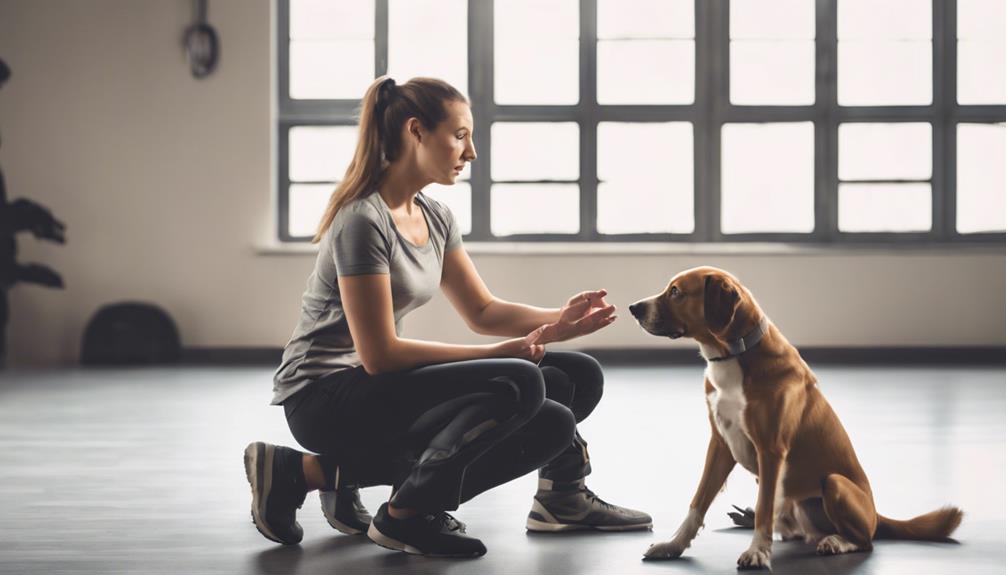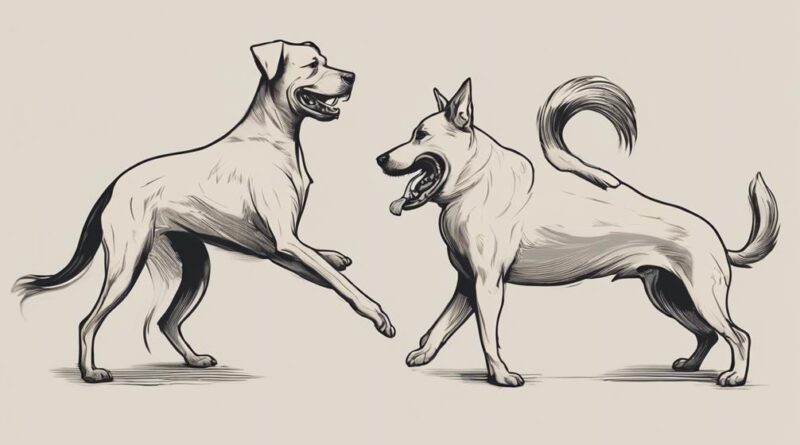Decoding Fear Aggression in Dog Psychology
Have you ever wondered why some dogs exhibit fear aggression?
Understanding the complexities of fear aggression in dog psychology can shed light on these behaviors.
By unraveling the underlying causes and learning to interpret your dog's signals, you can establish a deeper connection and provide the necessary support.
Mastering these insights will not only benefit your pet but also enhance your bond and create a harmonious living environment.
Understanding Fear Aggression in Dogs
If your dog exhibits fear aggression, understanding the root cause is crucial for addressing and managing the behavior effectively. Fear response in canine behavior can manifest in various ways, such as growling, barking, or even biting when they feel threatened or scared. It's essential to recognize that fear aggression is a defensive mechanism triggered by your dog's perception of a threat or danger.
Canine behavior experts suggest that fear aggression often stems from a lack of socialization, traumatic experiences, or genetics. Dogs may display fear aggression towards specific stimuli, such as strangers, loud noises, or other animals, as a way to protect themselves. Understanding your dog's triggers and cues can help you effectively manage their fear aggression and create a safe environment for them.
Recognizing Fear Triggers
Recognize fear triggers in your dog by observing their body language and reactions to specific stimuli that may elicit a fear response. Identifying common triggers can help you better understand your dog's behavior and provide appropriate support.
Some key triggers to look out for include:
- Loud noises: Dogs may react fearfully to sudden loud sounds like thunderstorms, fireworks, or construction noise.
- Unfamiliar people or animals: Meeting new individuals or encountering unfamiliar animals can trigger fear responses in dogs.
- Certain environments: Dogs may exhibit fear in specific places such as vet clinics, grooming salons, or crowded areas.
Managing fearful responses involves creating a safe and comforting environment for your dog, desensitizing them to triggers through gradual exposure, and using positive reinforcement techniques to build their confidence. By being attentive to your dog's triggers and responses, you can help them feel more secure and reduce fear-based aggression.
Impact of Body Language Cues
Observing your dog's body language cues can provide valuable insights into their emotional state and help you better understand their fear responses. Body language interpretation is crucial in decoding fear aggression in dogs. When your dog feels fearful, they may exhibit signs such as a lowered body posture, tucked tail, ears pinned back, and avoidance behaviors. These cues indicate that your dog is uncomfortable and anxious in a particular situation.
In addition to recognizing fear signals, it's essential to pay attention to calming signals that your dog may display. These signals include yawning, lip licking, sniffing the ground, or turning their head away. Calming signals are your dog's way of communicating that they're trying to de-escalate a tense situation and avoid conflict.
Handling Fearful Reactions Safely
When handling your dog's fearful reactions, prioritize safety by maintaining a calm demeanor and avoiding sudden movements. It's crucial to create a sense of security for your pet, helping them feel safe in their environment.
Here are some safety precautions and calming techniques to assist you in managing your dog's fearful reactions:
- Create a Safe Space: Designate a quiet, comfortable area where your dog can retreat when feeling anxious. Provide familiar items like blankets or toys to help them feel secure.
- Use Positive Reinforcement: Encourage good behavior with treats and praise. Rewarding your dog when they exhibit calm behavior can help build their confidence.
- Practice Desensitization: Gradually expose your dog to their fears in a controlled manner. Start with small exposures and reward them for remaining calm, slowly increasing the intensity over time.
Building Trust and Confidence
To help your dog build trust and confidence, establish consistent routines and positive interactions. Trust building and confidence boosting are crucial for addressing fear aggression in dogs. Communication cues and training methods play a significant role in fostering a strong bond with your furry companion. Consistency in your actions and reactions will help your dog feel secure and understand what's expected of them. Positive reinforcement techniques, such as rewards for good behavior, can boost your dog's confidence and encourage them to trust you more.
Creating a safe and predictable environment is key to building trust. Dogs thrive on routine, so providing a structured daily schedule can help reduce anxiety and fear responses. Use clear communication cues to guide your dog's behavior and reinforce positive actions. Training methods that focus on building confidence, such as desensitization exercises and gradual exposure to triggers, can help your dog overcome their fears. By investing time and effort into trust building and confidence boosting activities, you can help your dog feel more secure and less prone to fear aggression.
Implementing Behavior Modification Techniques
To effectively address fear aggression in dogs, implementing behavior modification techniques is essential for reshaping their responses and promoting positive changes in their behavior. Fear aggression can be challenging to deal with, but with the right approach, progress can be made.
Here are some key strategies to help you modify your dog's behavior effectively:
- Positive Reinforcement: Rewarding your dog for calm and non-aggressive behavior can help reinforce positive actions and encourage them to continue behaving in a desirable manner.
- Desensitization Training: Gradually exposing your dog to the source of their fear or aggression in a controlled and safe environment can help reduce their sensitivity over time and change their response to the trigger.
- Consistency and Patience: Consistent training methods and patience are crucial when implementing behavior modification techniques. It may take time for your dog to unlearn negative behaviors and replace them with positive ones, so stay committed to the process.
Seeking Professional Guidance

Professional guidance from a certified dog behaviorist can provide valuable insights and tailored strategies for addressing fear aggression in your canine companion. Behavior experts have the knowledge and experience to assess your dog's specific triggers and responses, creating a customized plan to help your pet overcome fear aggression. These professionals can offer guidance on how to modify your dog's behavior through positive reinforcement techniques, desensitization exercises, and counter-conditioning methods. By enrolling in training programs designed by behavior specialists, you can learn how to effectively communicate with your dog, set clear boundaries, and build trust to alleviate fear-based aggression.
Working with a behavior expert can also empower you with the skills and confidence needed to manage your dog's fear aggression in various situations. They can teach you how to recognize early signs of anxiety or stress in your dog and implement appropriate interventions. Through consistent guidance and support from a professional, you and your canine companion can work together to create a harmonious and fear-free environment.
Creating a Fear-Free Environment
Empower yourself to cultivate a fear-free environment for your dog by implementing proactive strategies and positive reinforcement techniques. To create a safe and comforting space for your furry friend, consider the following:
- Comforting Techniques: Utilize soothing tones of voice and gentle touches to reassure your dog during stressful situations.
- Positive Reinforcement: Encourage good behavior with treats, praise, and rewards to build confidence and trust in your dog.
- Safe Spaces: Designate a quiet area or a cozy den where your dog can retreat to when feeling anxious or overwhelmed.
In addition to these techniques, desensitization training can be a valuable tool in helping your dog overcome specific fears. By gradually exposing your dog to the source of their fear in a controlled and positive manner, you can help them learn to react more calmly and confidently.
Frequently Asked Questions
How Can I Determine if My Dog's Fear Aggression Is Due to a Past Traumatic Experience?
To determine if your dog's fear aggression stems from a past trauma, observe their behavior closely. Identifying triggers that evoke aggressive reactions can offer insights.
Behavior modification techniques like desensitization and counterconditioning can help address underlying fears. Consult a professional dog behaviorist for guidance tailored to your dog's specific needs.
Patience and consistency are key in helping your furry friend overcome fear aggression and live a happier, more relaxed life.
Can Fear Aggression in Dogs Be Completely Eliminated Through Training and Behavior Modification?
Yes, fear aggression in dogs can be improved through training techniques and behavioral modification. By identifying fear triggers and utilizing positive reinforcement, you can help your dog learn new, more positive ways to react to situations that trigger fear aggression.
Consistent training and patience are key to gradually reducing fear aggression in your dog, ultimately leading to a calmer and more confident pet.
Are There Any Specific Breeds That Are More Prone to Fear Aggression?
Some breeds may have tendencies towards fear aggression more than others. Behavioral triggers can vary depending on the individual dog, but certain breeds like Chihuahuas or Dachshunds are known for being more prone to fear aggression.
It's essential to understand your dog's breed tendencies and work with a professional trainer to address any behavioral issues effectively. Training and socialization play a crucial role in managing fear aggression in specific breeds.
How Can I Differentiate Between Fear Aggression and Other Types of Aggression in My Dog?
To differentiate fear aggression from other types, pay attention to your dog's body language and triggers. Fear aggression usually involves signs like cowering, ears back, and avoidance. Other types may show more direct, assertive behaviors.
Behavioral therapy and desensitization can help address fear aggression. Understanding the root cause is key to effective intervention.
Encouraging positive experiences and avoiding triggers can aid in managing your dog's behavior.
Is Fear Aggression in Dogs Something That Can Be Inherited Genetically?
Yes, fear aggression in dogs can have a genetic predisposition. While genetics can play a role, behavior modification techniques can also help manage this trait.
It's a blend of nature vs. nurture when it comes to fear triggers and aggressive behavior. Understanding your dog's genetic tendencies and using proper training methods can make a difference in addressing fear aggression.
Conclusion
Now that you have a better understanding of fear aggression in dogs, remember to always be aware of their triggers and body language cues. Safely handle fearful reactions with patience and build trust and confidence through positive reinforcement.
Utilize behavior modification techniques and seek professional guidance when needed. By creating a fear-free environment, you can help your dog feel safe and secure, leading to a happier and healthier relationship.
